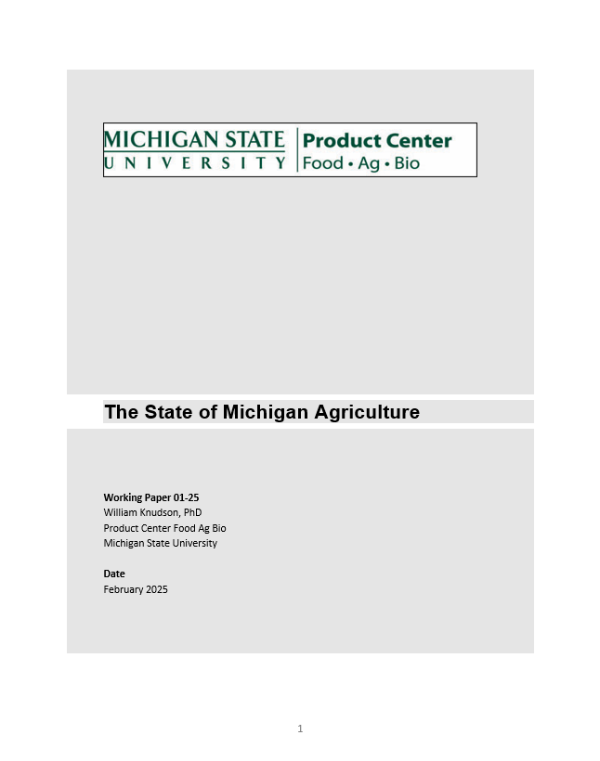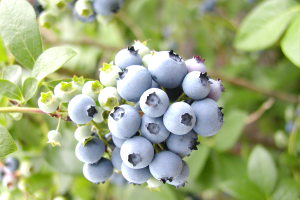
The State of Michigan Agriculture: 2025
DOWNLOADApril 9, 2025 - Bill Knudson, Michigan State University Extension
Overview
Michigan agriculture had a mixed year in 2023. Net farm income increased from $2.927 billion in 2022 to $3.517 billion in 2023; an increase of close to 20.16 percent. However, farm sales fell from $12.246 billion in 2022 to $11.554 billion in 2023; a decline of 5.65 percent. In 2023, lower prices reduced farm sales, and this was reflected in the lower cost of farm raised inputs such as feed which increased net farm income for livestock producers.
Michigan remains a major producer of some agricultural commodities. The state ranks first in the production of black beans and small red beans. It ranks second in the nation in the production of all dry beans. Michigan also ranks first in the production of asparagus, tart cherries, and squash. The state ranks second in the production of apples and cucumbers, fourth in the production of blueberries and sugar beets, sixth in the production of milk and potatoes, and seventh in egg production. The state also ranks in the top 15 in the production of winter wheat, turkeys, corn, hogs, and soybean production.
Often overlooked is the role Michigan plays in nursery, landscape, and floriculture products. It is the dominant producer of begonias, Easter Lilies, Geraniums, Impatients, Marigolds, Petunias, and Pansies.
Michigan remains an important producer of many agricultural commodities. It plays a critical role in floriculture production. It remains an important producer of corn, soybeans, and wheat. Furthermore, its role in livestock and dairy production appears to be increasing. This role may increase in the future if water shortages, regulation, and drought restrict output in the West and Southwest in the future.
Livestock and dairy
Dairy is the largest activity in terms of sales. In 2023, total milk sales were $2.41 billion. Dairy farming accounted for approximately 21 percent of all farm sales in the state. Milk sales declined by $473 million from 2022, or about 16.5 percent. This is due to a decline in the price of milk from $24.60 a cwt. in 2022 to $20.00 a cwt. in 2023. From 2012 through 2022, the number of dairy farms declined about 31 percent, but the number of dairy cows has remained fairly steady at around 440,000.
In 2023, Michigan beef producers sold 519.68 million pounds of beef and generated $832.48 million in sales. This represents an increase of in excess of $200 million or 31.9 percent compared to 2022. While the amount sold increased by 8.0 percent, most of the increase in sales was due to higher cattle prices.
Sales of hogs were $456.88 million in 2023, a decline of about $34 million, or 6.8 percent from 2022. Hog output has been consistent over the past few years, and there is a potential to increase production if additional workers at processing plants could be obtained.
The value of eggs produced was $707.3 million in 2023, a decline of 15.4 percent from the previous year. The number of layers was slightly lower in 2023. Most of the decline in 2023 was due to lower prices. Avian influenza is a major source of concern for the entire poultry sector.
The value of turkeys produced in 2023 was $206.8 million a decline of about $27.5 million, or 11.7 percent compared to 2022. Production was consistent although carcass weights were somewhat higher in 2023. The primary cause for the reduction in sales was lower prices for turkey.
The broiler industry in the state is small but appears to be growing. Broiler sales were $49.8 million in 2023. This is a decline of $12.4 million or 19.9 percent from 2022. However, sales in 2023 were up $21.4 million or 75.2 percent from 2019.
Major field crops
In 2023 Michigan farmers produced 346.08 million bushels of corn up slightly from 325.92 million bushels in 2022. This was due to an increase in total acres harvested of 2.06 million acres which was 120,000 acres more than 2022. The value of the corn produced was $1.488 billion which was a decline of $519 million, or more than 25 percent compared to 2022. This was entirely due to lower prices in 2023. The price of corn in 2023 was $4.30 a bushel, a decline of $1.86 a bushel from 2022.
One field crop that tends to get overlooked is hay. In 2023, Michigan farmers harvested 780,000 acres of hay, an increase of 10,000 acres from 2022. The price per ton in 2023 was $174 which was an increase of $9 from 2022. The total value of hay produced in 2023 was $326.00 million, an increase of $2.40 million from 2022. However, most of the hay produced in Michigan was used on the farm where it was produced. Sales of hay were $134.70 million in 2023.
Michigan farmers harvested 2.02 million acres of soybeans, a decline of 220,000 acres from 2022. Total production declined from 105.28 million bushels in 2022 to 92.92 million bushels in 2023, a decline of 12.36 million bushels. The value of production in 2023 was $1.21 billion, a decline of approximately $34 million. In addition to lower output, the price of soybeans declined in 2023. The price in 2023 was $12.80 a bushel a decline of $1.90 a bushel from 2022.
The value of wheat production in 2023 was $299.80 million in 2023, an increase of $34.23 million from 2022. Increases in acres more than offset the decline in price. Acres harvested in 2023 were 560,000, an increase of 145,000 acres. Yields were unchanged at 83 bushels an acre. The price fell from $7.71 a bushel in 2022 to $6.28 a bushel in 2023, a decline of 18.5 percent.
Michigan Potato growers produced 21.56 million hundredweight on 49,000 harvested acres. The value of potato production was $286.75 million, a decline of approximately $4.57 million. This decline was due to a decline in the price of potatoes. In 2023 the price was $13.30 a cwt. a decline of 60 cents from 2022.
Sugar beets saw a major increase in 2023. Sugar beet sales were $333.42 million in 2023 an increase in excess of $130 million over 2022. Sales have more than doubled since 2019.
Specialty crops
The value of Michigan apple production was $350.21 million 2023. This was a decline of $61.8 million from 2022. This is due to lower prices. In 2023, the price was 26.3 cents a pound, a decline of 4.6 cents from 2022. Production declined by 20 million pounds from 1.36 billion pounds in 2022 to 1.34 billion pounds in 2023.
The value of Michigan blueberry production increased by almost $5.9 million in 2023 to $120.47 million. This was due to more acres being harvested and an increase in the yield per acre. Michigan blueberry producers harvested 5,180 acres, an increase of almost 1,200 acres. The price in 2023 was $1.39 a pound, a decline of 28 cents from 2022.
While Michigan is the largest tart cherry producer in the country, the industry continues to face difficulties. The value of tart cherries produced in 2023 was $22.57 million. A decline of $13.61 million or 37.6 percent compared to 2022. This was due to a reduction in acreage, yields, and lower prices.
In 2023, Michigan growers harvested 28,500 acres of cucumbers with a total value of $58.74 million. This was a decline of $407,000. This was due to a decline in acres harvested and a slight decline in yields. The price of cucumbers rose by 90 cents in 2023 to $13.90 a cwt.
There was also a small decline in the value of squash production in 2023. The value of squash production was $40.04 million, a decline of $514,000. This was also due to a decline in yields per acre from 225 cwt. to 200 cwt. The price of squash increased by $2.60 a cwt. to $26.80 a cwt. 2023.
Michigan is the nation’s largest producer of asparagus, but that industry is also facing difficulties. As is the case with many commodities, rising labor costs is pressuring the profitability of the asparagus industry. The value of asparagus produced in Michigan fell from 2022 to 2023 by $936,000 to $29.13 million. This was due to a decline in acreage of 1,200 or more than 12 percent. The price in 2023 was $101.00 a cwt. an increase of $8.80 a cwt or 9.5 percent from 2022.
The total sales of floriculture production were $695.01 million a decrease of $16.19 million or 2.3 percent over 2022. Of this amount, $97.15 million were herbaceous perennials, $57.91 million were potted flowering plants, $23.88 million were foliage plants for indoor or patio use, and $384.60 were annual bedding or garden plants. From 2019 through 2023 glass greenhouse and open ground devoted to floriculture plants have been declining while other types of coverage have been increasing.
Summary
This brief analysis outlines the state of Michigan agriculture at the end of 2023. As such it is backward looking. A forward-looking outlook publication will be available in March of 2025. Michigan produces a wide variety of agricultural commodities and is a major producer of some commodities.
Table 1 outlines the sales of Michigan agricultural commodities in 2023.
Table 1: Sales of Michigan Agricultural Commodities 2023
| Commodity | Sales ($1,000s) |
| Rye | 2,351 |
| Wheat | 295,426 |
| Barley | 611 |
| Corn | 1,739,197 |
| Hay | 134,699 |
| Oats | 3,519 |
| Soybeans | 1,442,008 |
| Dry Beans | 218,994 |
| Potatoes | 292,872 |
| Asparagus | 29,133 |
| Snap Beans | 19,733 |
| Cabbage | 21,395 |
| Cucumbers | 58,737 |
| Pumpkins | 13,914 |
| Bell Peppers | 22,931 |
| Squash | 40,039 |
| Apples | 350,209 |
| Tart Cherries | 22,571 |
| Peaches | 19,066 |
| Blueberries | 120,470 |
| Maple Syrup* | 8,774 |
| Herbaceous Perennials | 97,146 |
| Potted Flowering Plants | 57,908 |
| Foliage Plants for Indoor or Patio Use | 23,880 |
| Annual Bedding/Garden Plants | 384,598 |
| Other Floriculture | 131,480 |
| Sugar Beets | 333,421 |
| Misc. Crops | 918,050 |
| Cattle and Calves | 832,479 |
| Hogs | 456,876 |
| Milk | 2,407,800 |
| Broilers | 49,812 |
| Eggs | 707,278 |
| Turkeys | 206,762 |
| Trout | 1,173 |
| Honey | 10,934 |
| Mohair | 8 |
| Wool | 238 |
| Other Animals and Products | 78,031 |
| Total | 11,554,523 |
*Figure for 2022
Total sales of Michigan agricultural commodities were $11.55 billion in 2023, this represents a decline of $691.43 million or 5.6 percent compared to 2022. Most of the decline was due to falling agricultural commodity prices.
Source
USDA Agricultural Statistics Service (2024). Michigan Annual Bulletin.



 Print
Print Email
Email




